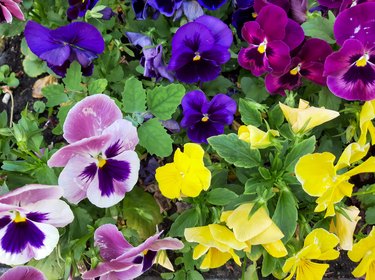
Although pansies (Viola x wittrockiana) can be perennial in U.S. Department of Agriculture plant hardiness zones 5 through 10, they usually are grown as cool-season annuals, to flower in spring or early summer in the north and in autumn and winter in the south. Gardeners often are advised to deadhead the plants to prolong their bloom, but they must allow some flowers to shrivel on stems if they want them to produce seeds. Keep in mind that open-pollinated pansies such as "Swiss Giant" (USDA zones 7 through 10) will come true from seed but hybrids won't.
Identifying Pansy Seed Pods
Video of the Day
The pansy's stigma appears atop the pistil at the center of the flower, that pistil being surrounded by anthers and backed by a conical green ovary. Pollen drops from the anthers into the indentation at the top of the lower petal and is carried to the overhanging sticky stigma by visiting bees. A pansy, therefore, can be fertilized by its own pollen or by the pollen bees transport to it from neighboring pansies.
Video of the Day
After pollination, the ovary behind the flower swells into a green seed pod, which remains on the stem after the petals fall. Eventually the pansy seed pods will dry and spring open, to reveal three boat-like valves filled with small brown seeds about 1/16 of an inch long.
Because the recoil of the pod's opening often flings seeds to the ground, enclose that pod in a collection sack when it no longer faces downward but stands out at a right angle to the stem. Make the sack from any porous material that can be placed over the pod and tied to the stem beneath it such as an inverted small muslin drawstring bag or a piece of old pantyhose.
Collecting Pansy Seeds
When you can feel through the covering that the pod has opened, snip the pansy stem and take the sack indoors to open it over a paper towel. Spread the seeds on the paper towel and leave them there for a week or so until they are completely dry. Afterward, store them in a paper packet inside a glass jar with a tight lid in the refrigerator. Pansy seeds don't retain their viability long, so plan to use them within one year.
Sow pansy seeds indoors, either in late winter three months before the date of the usual last spring frost for the area or in late summer three months before the date of the first fall frost. In either case, use a container that contains drainage holes, filled to within 1/2 inch of its top with seed-starting mix. Sow the seeds on the surface and sprinkle another 1/8 inch of the mix over them, patting it into place.
Germinate and Grow Seedlings
Because pansy seeds prefer darkness for germination, cover the container with aluminum foil and place it in a cool room where the temperature remains between 60 and 65 degrees Fahrenheit. Check the mix beneath the foil every day for sprouts, which should appear within seven to 21 days. When you see some, uncover the container and place it under a grow light in the same cool room.
Keep the seedlings' mix damp and feed them once every two weeks with a fish and seaweed plant food such as 2-3-1, at half strength -- mixing about 1 1/2 teaspoons of the emulsion into each 1 gallon of water. At the end of their first month, increase that amount to 1 tablespoon per 1 gallon. When the seedlings each have two sets of leaves, thin or transplant them to stand at least 1 inch apart.
Transplant and Nourish Seedlings
After the seedlings have grown for two months indoors, transplant them into the ground outdoors one month before the last spring frost or one month before the first autumn frost. Gradually accustom them to the brighter outdoor conditions for about a week before transplanting.
Choose a site with rich and well-drained soil, in sun or partial shade, and set the plants about 7 inches apart. Make sure they receive at least 1 inch of water per week and continue to feed them once every two weeks with the fish/seaweed plant food, increasing the amount to 2 tablespoons of emulsion per gallon of water.